Abstract
Culture contributes immensely to the performance of different organizations, particularly in the case of international of corporations and multinational organizations that employ expatriates (expats) and nationals. The current paper discusses the impacts of various cultural dimensions on UAE-based organizations’ performance. It develops its arguments through the deployment of literature review. The analysis section uses information that is developed in the literature review section. Consequently, the recommendations and conclusions are based on the findings from the literature review. Upon reviewing the literature, the paper argues that the UAE’s performance management is influenced by high power distance in the nation, low individualism, average masculinity, and high avoidance of insecurity risks. Besides, legal requirements such as Emiritization policies limit the extent to which organizations can choose human resources to employ to deliver optimal performance.
Introduction
Different cultures have different mechanisms for dealing with issues of authority in organizations, innovation and creativity, corporate governance, and bureaucracy. An organization also operates under the influence of external and internal factors, which influence decision-making processes and approaches to managing human resources (Altarawneh 2016). The internal environment determines an organization’s culture. In the case of external environment, an organization has to deal with ownership issues to successfully launch and operate in foreign nations, including the UAE. The characteristics of an organization’s shareholding may influence its policies. For example, multinationals who operate in the UAE, but established in a different nation, have an operational culture that relates to the country of origin. However, they are required to align their corporate policies to with those of the UAE to operate with minimal cultural conflicts. Therefore, such organizations also experience socio-cultural differences, including power and its management and paternalism, which directly influence the development and implementation of various human resource policies. These issues relate to the cultural context, which affects performance management approaches for any organization.
People make critical decisions, which can lead to the success or failure of the organization in question. To this extent, organizational effectiveness is a function of managerial approaches that are developed and implemented through critical decisions made by managers with respect to motivation, innovation and creativity, and change management among other issues that influence employee performance (Baird, Hu, & Reeve 2011; Krishnaveni & Arthi 2015). Performance management implies creating job contexts that an organization is involved in while at the same time measuring employee performance. Creation of the context relates to the employee and organizational cultures. Hence, cultural dimension and performance are related. From this paradigm, this paper focuses on cultural dimensions and the impact they have on performance management in the UAE market. Before the analysis of the various cultural dimensions, the paper first conducts a literature review.
Literature Review
Performance Management and Cultural Context
Performance may be related to a firm’s efficiency and effectiveness. Performance management deploys the learning that is acquired from past business operations to build on actions that are necessary for achieving an organization’s targets (Koc 2011). Organizations use various steps to manage their performance effectively as shown in Chart 1.
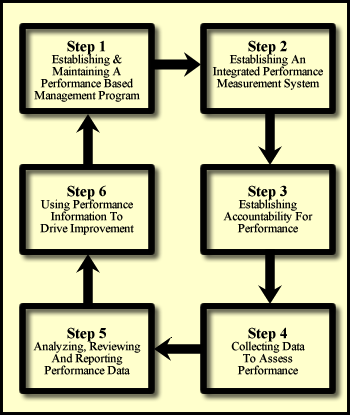
One of the critical concerns in performance management is that people are the main sources of an organization’s competitive advantage. In a bid to increase performance, through their human resource management, organizations establish strategies for motivating employees (Cegarra-Leiva, Sa´nchez, & Cegarra-Navarro 2012). This effort is consistent with the existing evidence on the role of HR in enhancing organizational performance. For example, Lambert (2011) states that effective HR practices aid in increasing employee satisfaction, motivation, and their commitment. Satisfied employees are more likely to execute their roles within an organization better than those who are dissatisfied (Chaudhry & Sabir 2010). Indeed, job satisfaction relates to employee motivation. The two elements are essential components for enhancing organizational performance (Crede et al. 2011; Lambert & Vicki 2012). Consequently, whether an organization in the UAE employs expatriates or nationals, a performance management strategy that seeks to motivate, increase employee satisfaction, and/or ensure organizational commitment is necessary for amplified performance.
Highly performing organizations focus on mechanisms for creating wealth, which is then directed towards the improvement of employee welfare. Indeed, ‘People are always angered and frustrated by perceived inequality in reward systems’ (Bowey 2012, p.17). Hence, if people are managed in a manner that they are motivated through reward systems, then it is possible for an organization to improve its performance. This claim suggests a direct relationship between salaries and welfare benefits that are awarded to employees and their performance levels in terms of their execution of organizational tasks. Such welfare benefits help to improve profitability and hence the performance. Indeed, as shown in Chart 2, performance management is a process that requires the integration of various cultural aspects.
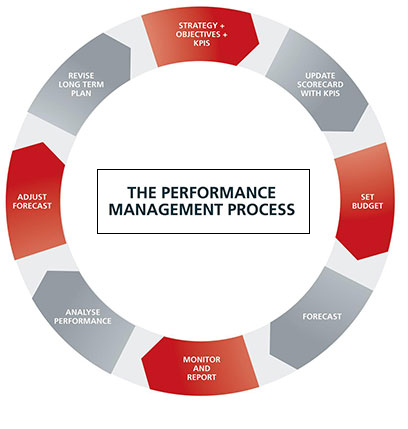
Organizations, which have uniform systems for engaging employees, stand better chances of outperforming their competitors. Tucker, Thorne, and Gurd (2011, p.141) support this argument by informing, ‘it is great when companies try to improve employee engagement and even better when they measure it’. This assertion implies that assessment of the capacity of an organization to engage its employees begins with the derivation of an appropriate scale for engagement measurement. This strategy helps in determining the required actions, which are missing or are inconsistent with the different channels of an organization, to promote homogeneous engagement strategies (Tucker, Thorne, & Gurd 2011). In case the assessment is not conducted by measuring the appropriate and the right things, chances are that the strategies implemented to foster organizational engagement will not produce any measureable impacts in terms of realizing better business outcomes, which form the bottom line concerning the enhancement of organizational performance. According to Johnson and Keddy (2010), academicians and organizational leaders have communicated the significance of managing organizational diversity to guarantee success and/or encourage a culture of innovation and creativity. Embracing diversity means that organizations are led as heterogeneous entities, rather than homogenous bodies.
A homogenous organization is a non-diversified body while a heterogeneous is diversified entity. Heterogeneous organizations employ people of varied backgrounds in terms of race, age, physical abilities, and geographical regions among others. Effective management of workforce diversity has been acclaimed by leadership scholars as having the ability to improve workforce productivity, workforce engagement, eliminating staff absenteeism, and/or increase workforce turnover by about five folds (Moore 2015; Bealer & Bhanugopan 2014).
An increasing number of scholarly studies reveal a direct correlation between employees, their attendance, job performance, dedication, and perception of being valuable resources of an organization through the appreciation of their diversity. For instance, Corredor and Goñi (2011) assert that organizational leaders who fail to understand that women and minority employees are valuable resources for achieving success suffer from reduced productivity. This claim infers that mismanagement of workforce diversity translates into increasing an organization’s operations costs. In this context, organizations, which do not support diversity in their workplaces, are likely to plunge into expensive lawsuits, including out-of-court settlements for cases such as stereotype propagation, discrimination, and harassment that are fuelled by poor management of various culturally diverse talent pools. Such organizations are susceptible to costs that are linked to employee replacement (Beechler & Woodward 2010). Subsequently, their performance is also negatively impaired.
Upon noting the value of managing cultural dimensions to enhance organizational performance, Reddy (2011) asserts that organizations should respond to culture challenges that may impair their performance. For international organizations, such bodies need to ‘identify the developing cultural challenges and develop practices to meet the global competitiveness, flexibility, and learning capabilities’ (Reddy 2011, p.301). This situation has the implication of enabling an organization to construct cultural sensitivities coupled with abilities to guarantee effective management of their performances. This strategy underlines the need for organizations to develop and understand the available alternatives or frameworks for conducting an analysis of their cultural differences that can impede their performance.
Reddy (2011) contributes to the scholarly debate on culture and cultural dimensions and its effects on performance. He identifies individualism, avoidance of uncertainty risks, and power distance as important factors that affect organizational beliefs and attitudes. Together with other cultural constraints, these issues may comprise incredible detriments to successful performance management policy implementation. Reddy (2011) suggests that developing cultural values and beliefs constitutes critical initiatives, which potentially facilitate performance management processes. Each nation has unique cultures and cultural dimensions that influence both organizations and people who work therein. Therefore, a discussion of culture and cultural dimensions and their effects on performance management should focus on a specific nation. Having argued that culture has an effect on performance management, the next sections discuss its effects focusing on the UAE as the specific nation while narrowing the debate to expatriates versus nationals.
Culture and Cultural Dimensions in the UAE
Culture defines a set of beliefs, norms, various values, and assumptions that help in grouping people. It involves programming people’s mind in a manner that differentiates them from any other group (Reddy 2011). In organizational settings, culture varies from one nation to another. It is manifested in various positions that are held by an organization with respect to issues such as diversity and power. In the debate of expats versus nationals in the UAE, the debate on culture and cultural dimensions may be well analyzed in the context of motivational orientation and the relationships that exist among different people in an organization.
The UAE hosts various expats who mainly work for various Multinational Corporations (MNCs). However, the nation requires such organizations to put the interest of the UAE residents prior to those of the expatriates from their home country. For example, the UAE introduced the emiritization program in 2004. The program seeks to ensure that organizations employ more UAE nationals (Reddy 2011). The main purpose of the program is to reduce dependence on foreign workforce in the UAE. The law hinders employers from considering employing other nationals if UAE nationals are available and able to execute the task for which the expat is employed to execute (Reddy 2011).
Although labor laws establish some free zones such as DHC and DIFC, in which the UAE labor laws do not apply to foster foreign investments, the provision of the 2004 emiritization program may apply to some free zones. Therefore, limitation of the freedom of the extent to which an organization can chose its employee pools implies that an organization cannot seek to optimize performance by selecting a foreign national candidate to fit in a given job without considering the emiritization policy. Indeed, this policy entails a cultural aspect for organizations that operate in the UAE.
In a situation where an organization wants to seek the services of an expat, the UAE places some requirements that must be complied with. For example, before employing an expatriate in the UAE, an application with the Ministry of Labor is required. The ministry has the sole mandate of authenticating the application before any employee arrives in the UAE. Apart from seeking approval for employing people from outside the UAE, an organization must meet some immigration procedures. For instance, since the organization wants to employ people from different nations, it must draw its contract in formats that are acceptable by the ministry of labor. In the contract, an organization needs to stipulate several things such as payable wages or salaries, employment contract date, commencement date for the contracts, contract nature (limited or unlimited), the nature of the job the employees will be involved in, the place of work, and period that the contract will last.
The above conditions have the effect of promoting the cultural dimension of employing only UAE nationals to avoid reliance on foreign nations’ sourced labor. Consequently, an organization may consider employing a UAE national instead of going through the vigorous verification processes for importing expat labor. Consequently, fast decision-making, which is necessary in effective performance management, encounters obstacles due to the cultural dimension. Cultures and their dimensions are played out by various variables such as collectivism, individualism, masculinity, feminism, uncertainty avoidance, and power distance (Reddy 2011). Graph 1 shows the UAE’s measures for these dimensions while Graph 2 compares the Arab world, where the UAE is located, including other nations in terms of these aspects.
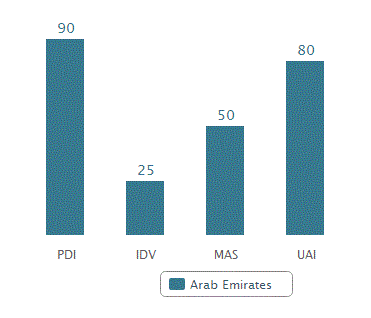
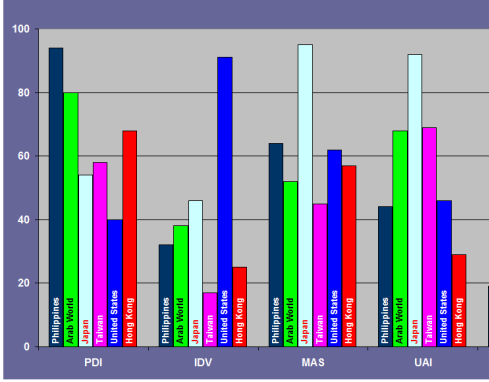
Individualism versus Collectivism
Individualism versus collectivism implies the extent to which people remain integrated within groups and/or tend to care about themselves together with their close families. Individualistic cultures demonstrate weak ties among individuals (Reddy 2011). All people put their individualistic interest ahead of the interests of any other person. Collectivist cultures require all people to integrate and develop cohesion in various societal groups. People need to continue subscribing to the norms and values of these groups without ever questioning the norms and/or binding people together. Individualism may be measured using the Individualism Index (IDV). As shown in Graph 2, the Grey Chronicle (2010) indicates that developed nations possess the highest IDV values.
As indicated in Graph 1, the UAE score for IDV is 25. Hence, it has a collectivist culture, which is manifested through its strong ties with extended families and/or extended relationships. Therefore, the society is guided by loyalty to regulations. Since management decisions in such a nation are based on effective management of groups, organizations have to ensure that their expats’ workforce fosters the development of a work group culture to minimize organizational conflicts. The UAE faces the challenge of cultural harmonization of nationals and expats such as the US citizens who may be used to individualist cultures (as shown in Graph 2) and the nationals who are accustomed to collectivist values.
Masculinity versus Femininity
In any society, culture may be played out from different dimensions such as masculinity and femininity. Masculinity entails a cultural dimension in which gender roles become distinct by spelling out characteristics that men should display. Such traits include materialism, assertiveness, and toughness among others. Femininity defines various traits that women should highlight, for instance, tenderness, modesty, and responsiveness to changes in the quality of life.
Issues of femininity and masculinity emerge from perceived emotional differences between men and women within a nation. Masculinity Index (MAS) indicates distinctions of gender roles coupled with different work expectations between the two genders. Graph 2 indicates that Japan has the highest MAS. From Graph 1, the UAE’s MAS is 50. This figure shows that the society is propelled by concerns of achievement, success, and competition. It equally relies on dominant values for ensuring quality life coupled with caring for other people. The nation is not masculine or feminine. Such a position is important in helping to balance the needs and concerns of value systems for both expats and nationals (Puck, Kittler, & Wright 2008). However, Graph 2 depicts a concern about high masculinity value system of expats who may be drawn from Japan.
Uncertainty Avoidance in the UAE
The Uncertainty Avoidance Index (UAI) measures the extent to which people are satisfied or unsatisfied with unstructured systems. It indicates the mechanisms for dealing with future unknown expectations (Reddy 2011). As shown in Graph 2, different nations have different UAIs. Japan has the highest level of intolerance to uncertainties. Taiwan and the Arab World are equally intolerant to uncertainty risks. From Graph 1, the UAE’s UAI score is 80. Therefore, expats from nations with low tolerance to uncertainty risks such as Hong Kong and Philippines, as shown in Graph 2, are likely to face challenges while working in the UAE public and private sectors.
Power Distance in the UAE
Power is necessary in decision-making and the implementation of organizational policies. Reddy (2011) asserts that people in an organization anticipate power to be equally shared. This aspect is measured using Power Distance Index (PDI). The dimension underlines the perspective that the society and individuals are unequal. The Hofstede Center (2016, (Para.2)) defines power distance as ‘the extent to which the less powerful members of institutions and organizations within a country expect and accept that power is distributed unequally’. The measure expresses the attitudes of different cultures towards power inequalities.
From Graph 1, the UAE has a PDI of 90. This figure suggests that the highest proportion of nationals recognize and/or accept the existing hierarchical positions of power. In an organizational context, this situation reflects the reliance of a benevolent autocrat leader who gives directions to subordinates. While this situation may be the norm that is acceptable to all nationals, a debate has been raised on whether expats who work in MNCs, especially those from the US, which has a PDI of 40 as indicated in Graph 2, should also operate under the same power distance levels. This information is important, considering that such people may have been drawn from nations whose democratic systems permit equal power distribution as expressed through the delegation of responsibilities (Forstenlechner 2010). Delegation of power is a way of increasing the performance of employees, especially highly skilled and talented employees. Such employees are not motivated by monetary rewards (Brockbank 2010).
Performance Management and the Expectancy Theory
The UAE has a high population of expats compared to nationals as shown in Graph 3.
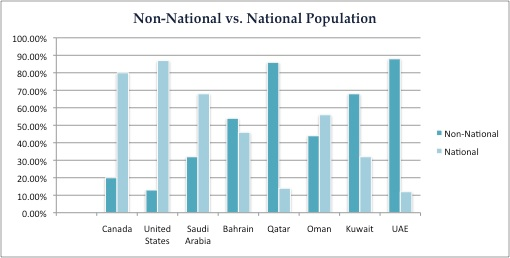
From Graph 3, the UAE has one of the highest numbers of non-nationals across the world. These people, who constitute the expats, help to sustain its economic growth. Nationals are mainly employed in the public sector due its association with higher pays and job security (Forstenlechner 2010). As shown in Graph 4, most expats are in the private sector in the UAE
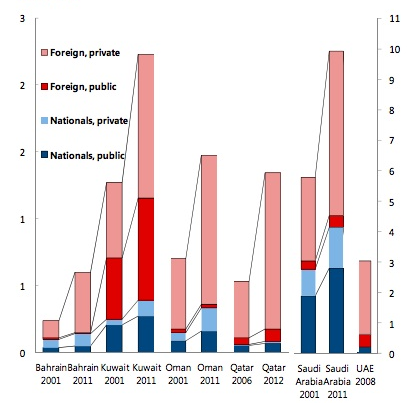
From Graph 4, as of 2013, the UAE had no significant number of nationals working in the private sector. Although expats were higher in the public sector compared to the nationals, majority of expats were in the private sector. The UAE labor force relies mainly on the expats who make over 90% of the population (The NATO Association of Canada 2015). Considering the contribution of expats in ensuring that the economy of the emirates continues to function as it should, the major debate is on how the UAE can increase the performance of both the nationals and expats.
One of the mechanisms that the UAE can deploy to increase the performance of both expats and the nationals is by deploying the expectancy theory in performance management. The theory explains why some people choose one set of behaviors and not the other. It asserts that people may be effectively motivated towards achieving a given goal in case they are aware that a correlation exists between the input (effort) and the output (performance) and that a reward of varying in magnitude to the performance exists (Bierbusse & Siesfeld 2011). Such a reward ensures that the input (effort) is worthwhile.
The expectancy theory comprises three main components, namely expectancy, valence, and instrumentality (Simone 2015). Expectancy implies that efforts lead to the expected performance. The instrumentality aspect implies that performance leads to the outcome. Valance means that an outcome leads to a reward (Simone 2015). Hence, when employing the expectancy theory in expats and nationals’ performance management in the UAE, the main objective is to ensure that effort levels measure up to the reward given. Should the UAE’s public sector absorb a higher percentage of nationals due to the higher pay than an equal percentage of expats? Should the expats and nationals earn equal wages and salaries or the reward system be based on performance levels as the expectancy theory suggests? The above questions continue to be a major debate in the UAE labor sector.
Analysis
Cultural Context of Performance Management
Performance management is an essential tool for evaluating the ability of an organization to remain in business in the short and long term. Beechler and Woodward (2010) argue that profit-making organizations deploy profitability levels as measures of their performance. To this extent, profitability encompasses a desired organizational output. Performance measurement entails ‘three specific areas of a firm outcomes: financial performance (profits, return on assets and return on investment); product market performance (sales and market share); and shareholder return (total shareholder return and economic value added’ (Sadikoglu & Zehir 2010, p.15). The standard approach to measuring performance involves setting targets for the desired outputs and then measuring the actual outputs against the targets for these three aspects.
To achieve the targets, organizations develop different policies for dealing with potential risks that hinder the achievement of the targets. Indeed, performance management that is based on achieving targets as the anticipated outputs underlines the applicability of the expectancy theory in the UAE’s private and public sector organizations that employ both expats and nationals. However, cultural dimensions as measured from PDI, UAI, MAS, and IDV have implications on the capacity of expats and nationals to achieve some targets, which can constitute the criteria for a reward system. Chart 3 illustrates a process that can be used in rating the performance of each expat or national UAE employee before a reward that is commensurate to the amount of effort can be established with reference to a corresponding increase in output as suggested by the expectancy theory.

Culture plays out in various ways, including religion. Religion defines a set of beliefs, perceptions, and cultural systems that relate to the understanding of society’s existence. Religion is characterized by various symbols, sacred histories, and stories about the purpose of life, its origin, and the origin of the universe. Religious beliefs shape morality and ethics. They also prescribe a certain lifestyle through a set of codes of acceptable behaviors within the doctrines of a given religion (Strayer 2011). Different societies have diverse value differences. The UAE nationals are predominantly Muslims. Expats have mixed religious inclinations such as Islam, Christianity, and Hinduism among others. Since expats and nationals interact in the work environment, a question emerges on whether value difference, including religious orientations, may influence the collective work group performance of employees in the UAE.
The management has the role of ensuring that cultural differences such as religious stance and affiliation do not affect performance. For example, in case a manager is a Muslim, he or she needs to understand that he or she leads organizations that have people from different religious backgrounds. Thus, such leaders need to understand that religion comprises one of the value systems that may influence their success in ensuring consistent employee performance due to religious differences that may give rise to destructive workplace conflicts (Kawar 2012). Value differences may also emanate from different traditions, perceptions of gender roles, and other ways of doing things among the UAE nationals and expats. Hence, a primary mechanism for addressing challenges in the UAE nationals versus expats’ ability to sustain higher performance rests on integrating the value differences of the two groups of people by adopting the appropriate HRM approaches to diversity management (Sakiru & D’silva 2013).
The HRM constitutes an integral aspect of performance management. The HRM has the responsibility of establishing remuneration packages and motivating and training employee on cross-cultural organizational development and conflict resolution mechanisms within an organization (Kassar, Rouhana, & Lythreatis 2015). However, HRM approaches cannot be standardized to apply in all cultural contexts. Reddy (2011, p.307) supports this line of argument by claiming, ‘practices and processes of human resource management can be linked to other countries, but this difficult process can lead to differences in perception to become a debatable issue’. HRM approaches are perhaps important for organizations that operate in the UAE, especially MNCs, which seek to recruit expats from foreign nations. Legal requirements have been laid down when recruiting nationals first to preserve the local culture. Any violation attracts penalty (Reddy 2011). Consequently, successful operation in the UAE will require HRM to link MNC’s corporate and business level strategies to the local culture. Hence, the expats’ culture is often prejudiced in favor of the local culture.
Cultural Dimensions in the light of the Performance Management
Cultural dimensions in an organization not only play out in the form of differences among people because of their diversity differences, but also in the form of organizational culture. To ensure that all stakeholders of an organization focus on common goals and objectives, it is important for them to subscribe to a common way of thinking, interacting, and upholding values and norms (Anand & Udaya 2010). Organizational norms, values, and ways of thinking define an organizational culture, which needs to be aligned with the business of an organization. Organizational culture elements constitute some basic assumptions that when adopted and observed by all the stakeholders of an organization, especially the diverse workforce, can aid in enhancing the performance of an organization. Considering that the UAE labor industry constitutes not only the UAE nationals but also expat employees who have different cultural background, an important issue that may determine the performance levels of both public and private sector organizations is whether organizational culture fosters multiculturalism (Harrison & Michailova 2012).
Trust, initiative, and equality are the three main pillars that driving the culture of respect for individual in driving organizational performance. From the perspective of equality, the norm of respect for individuals implies recognizing and respecting differences among individuals, treating every individual fairly, and building long-term mutual relationships (Ollapally & Bhatnagar 2010). Balancing of cultural dimensions among employees demands the allocation of opportunities that are available in a company based on individual capabilities, rather than sex, race, socio-economic status, nationality, age, or educational background. Hence, for optimal performance of both UAE nationals and expats, people who work and/or interact with the UAE organizations in both private and public sector need to see an organization as embracing the contribution of people in its success only through the differences in individual capability and talent potential, but not nationality.
Any management practice requires the deployment of feedback to determine the extent to which the preset targets have been achieved. Any performance measurement process must possess a mechanism for providing feedback to the developed success strategies (Brockbank 2010). In case of the UAE, one of the feedbacks is the effectiveness of the performance management approaches within the cultural context of the nation’s expats and nationals. For example, from the literature review, it was argued that the UAE has a high rating of power distance. This finding implies that its cultural context of nationals is based on compliance with the established guidelines by autocratic and benevolent organizational leadership. Therefore, increased performance may be enhanced through establishing higher targets and then directing employees to achieve the targets.
The UAE’s performance management approaches need to reflect the cultural dimensions of the expatriates who are mainly from nations that may have opposing cultural values and norms. This strategy is especially important upon noting that people from foreign nations (over 90%) mainly dominate the UAE labor force. Indeed, incorporation of cultural dimensions in the UAE’s performance management is necessary since the expats are also giving birth. Hence, the UAE will continue to rely on expats in driving its economic success. Graph 5 illustrates the original nations of the UAE foreign-born residents
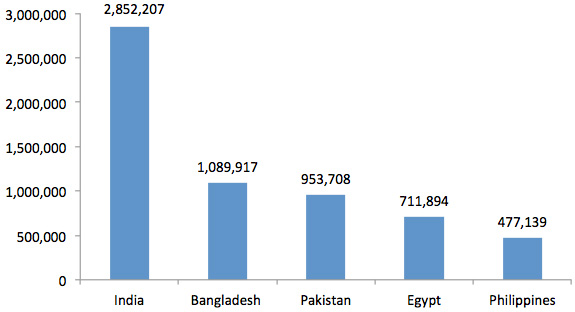
People implement performance management approaches. Since performance management uses appraisal system to determine the appropriate strategies for increasing performance, the cultural context of people who conduct the appraisal can influence the interpretation of information relating to people’s behavior. For example, a good behavior such as the collectivist attitude in the UAE national cultural context may be not justified in the expats’ cultural context. This difference has implications when it comes to understanding the concept of performance management appraisals as interpreted in different cultural value systems.
The discussion in the literature review sections reveals how management in an organization has the responsibility of determining the appropriate amount of power that is allocated to employees to foster innovation and creativity. Fundamentally, innovation means the introduction of something new. In the business settings, innovation takes place when ‘new products or services are introduced and successfully commercialized’ (Martin 2010, p.67). In the manufacturing context, innovation involves the introduction of new manufacturing processes coupled with practices, new technologies, and new materials among other things, which help to lower the cost of production or increase the pace of production and quality of the manufactured products. However, even in the service sector, empirical research shows that innovation has the ability to make organizations develop better quality and low-priced services (Dorner, Gassmann & Gebauer 2011; Von Stamm 2012). Innovation and creativity cannot exist in an environment where the capable and highly talented employees lack adequate power to make self-directed trials for new technologies and potential new processes that can lead to cost saving. Hence, the UAE needs to study and make appropriate changes to its value systems that evidence a high power distance as depicted in Graph 1.
Recommendations
The UAE MNCs and other organizations that employ expats and nationals need to establish performance management approaches that reflect different cultural dimensions of the workforce. Performance feedback can be provided by evaluating the financial performance of an organization upon implementing a strategy of performance improvement. A recommended approach to accomplishing this goal entails evaluating the return on organizational investments, including changes in organizational assets, and assessing the changes in the profitability of an organization.
A second recommended approach encompasses evaluating performance management strategies from the context of increment in the market share of an organization, changes in sales level, and even changes in the shareholder returns in the form of increased magnitude of dividends. However, it is important to understand that changes that indicate improvement in these performance elements are not complete indicators of the increased performance of an organization without the incorporation of cultural dimensions.
Performance management relies on appraisal systems in the development of appropriate strategies for encouraging behaviors that may lead to higher performance. However, expats and the UAE nationals may interpret different cultural dimensions differently. For example, individualism may help to encourage people to perform higher if additional effort is commensurately rewarded in accordance with the expectancy theory. This plan may work for expats from individualistic cultures such as the US and Japan. However, in a collectivist culture, for instance, the UAE, the strategy will not work. Therefore, in the UAE context, performance management approaches should be tailor made to suit each employee’s cultural dimensions.
Although the UAE has its unique cultural dimensions, which influence the manner in which public and private sector organizations operate, it is recommended that organizations should consider establishing their unique cultures that blend both the expats’ culture and that of the nationals. This move will lead to the development of a multiculturalist civilization where no single individual or group of people who work for any UAE incorporated or MNC organization can identify processes, work structures, or any other organizational policy as inherently related to its culture. This move can help to minimize the likelihood of organizational conflicts due to mismatch of policies, work structures, and even processes with one’s unique culture. Hence, MNCs that operate in the UAE should alter some of value systems that are influenced by the UAE cultural dimensions to encourage the distribution of organizational power, which helps to empower employee innovation and creativity. This strategy can help in incubating top talent, which can lead to innovation, which aids in reducing the cost of production. The outcome is an increase in organizational output in terms of financial performance. Extending power to employees can also help in increasing their motivation coupled with organizational commitment, which can help to amplify their output potential.
Conclusion
Performance management involves the creation of contexts and the measurement of organizational performance. It refers to the development of policies for future success and application of a set of actions, goals, and objective to achieve some specified targets within an organization. As argued in the paper, performance policies need to reflect cultural dimensions within a nation where an organization operates. The cultural context for expats differs depending on the nation of origin of the individual expats. Therefore, similar performance levels may not be achieved through approaches that work for the UAE nationals’ cultural context. For instance, performance-based reward system may function well as a mechanism for inducing higher performance for the case of expats. Strategies for increasing performance, whether in public or private sector, need to reflect the cultural dimensions for all employees.
In a nation such as the UAE where nationals and expats from multicultural contexts work together, a multicultural organizational structure that is built on the tenets of trust is necessary. Organizations can create trust by insisting on the need for people to help others where they are deficient, welcoming help where necessary, and/or sharing knowledge, despite the cultural differences among employees. Through cultural driver aspects such as initiatives, the UAE organizations can ensure that people’s performance is not limited by their culturally preconceived arguments and ideas. Rather, they require thinking in a creative and innovative manner, which is driven by their initiative and/or judgment, to foster their performance. Most importantly, expats and UAE nationals need to appreciate that their initiatives match their organizations’ responsibilities and objectives, but not their individual cultural differences.
References
Altarawneh, I 2016, ‘strategic human resource management and its impacts on performance: the case from Saudi Arabia’, International Journal of Business Management and Economic Research, vol. 7, no.1, pp. 486-503.
Anand, R & Udaya, G 2010, ‘Emotional Intelligence and Its Relationship with Leadership Practices’, International Journal of Business and Management, vol.5, no. 2, pp. 63- 69.
Baird, K, Hu, J & Reeve, R 2011, ‘The Relationships between Organizational Culture, Total Quality Management Practices and Operational Performance’, International Journal of Operations and Production Management, vol.31, no.7, pp. 789–814.
Bealer, D & Bhanugopan, R 2014, ‘Transactional and transformational leadership behavior of expatriate and national managers in the UAE: a cross-cultural comparative analysis’, International Journal of Human Resource Management, vol. 25, no. 2, pp. 293-316.
Beechler, S & Woodward, C 2010, ‘The Global ‘War for Talent’, Journal of International Management, vol.15, no.7, pp. 273–285.
Bierbusse, P & Siesfeld, T 2011, ‘Measures that matter’, Journal of Strategic Performance Measurement, vol.1, no.2, pp. 6–11.
Bowey, A 2012, ‘Motivation: The Art of Putting Theory into Practice’, EBF, vol. 20, no.1, pp. 17-20.
Brockbank, W 2010, ‘If HR Were Really Strategically Proactive: Present and Future Directions in HR’s Contribution to Competitive Advantage’, Human resource management, vol.38, no. 4, pp. 337-352.
Cegarra-Leiva, D, Sa´nchez, V & Cegarra-Navarro, G 2012, ‘Work life balance and the retention of managers in Spanish SMEs’, The International Journal of Human Resource Management, vol. 23, no.1, pp. 91-108.
Chaudhry, M & and Sabir, H 2010, ‘Exploring the Relationship between Salary Satisfaction and Job Satisfaction: A Comparison of Public and Private Sector Organizations’, The journal of commerce, vol.3, no.4, pp. 325-364.
Corredor, P & Goñi, S 2011, ‘TQM and Performance: Is the Relationship So Obvious?’, Journal of Business Research, vol. 64, no.8, pp. 830–838.
Crede, M, Chernyshenko, O, Bagraim, N & Sully, M 2011, ‘Contextual performance and the job satisfaction–dissatisfaction distinction: Examining artifacts and utility’, Human Performance, vol.2, no. 2, pp. 246–272.
Dorner, N, Gassmann, O & Gebauer, H 2011, ‘Service innovation: why is it so difficult to accomplish?’, Journal of Business Strategy, vol.32, no.3, pp. 37-46.
Forstenlechner, I 2010, ‘Workforce localization in emerging Gulf economies: the need to fine-tune HRM’, Personnel Review, vol.39, no.1, pp. 135-152.
Harrison, E & Michailova, S 2012, ‘Working in the Middle East: Western female expatriates’ experiences in the United Arab Emirates’, International Journal of Human Resource Management, vol. 23, no. 3, pp. 625-644.
Johnson, C & Keddy, J 2010, Managing Conflict at Work: Understanding and Resolving Conflict for Productive Working Relationships, Kogan Page, London.
Kassar, A, Rouhana, A & Lythreatis, S 2015, ‘Cross-cultural Training: Its Effects on the Satisfaction and Turnover of Expatriate Employees’, SAM Advanced Management Journal, vol. 80, no. 4, pp. 4-18.
Kawar, T 2012, ‘Cross-Cultural Difference in Management’, International Journal of Business and Social Science, vol.3, no.6, pp. 105-111.
Koc, T 2011, ‘The Relationship between TQM and Performance in Small Manufacturing Enterprises: The Meditation Effect of Failure’, International Journal of Industrial Engineering, vol.18, no.4, pp. 203–218.
Krishnaveni, R & Arthi, R 2015, ‘An Overview of Multidimensional Factors Influencing Effective Performance of Expatriates’, Management: Journal of Contemporary Management Issues, vol. 20, no. 2, pp. 135-147.
Lambert, C & Vicki, M 2012, ‘The Top Three FLSA Violations and How to Avoid Them’, Journal of Human Resource Management, vol.12, no.3, pp. 306-313.
Lambert, J 2011, ‘Added Benefits: The Link between Work Life Benefits and Organizational Citizenship Behavior’, The Academy of Management Journal, vol.2, no.1, pp. 7-32.
Malit, F & Al Youha, A 2013, Labor migration in the United Arab Emirates; changes and responses, Web.
Martin, K 2010, Innovation, Ethics and Business, Institute for Corporate Ethics, Sidney.
Moore, B 2015, ‘Excellence in performance management’, Public Management, vol. 97, no.11, pp. 26-28.
NEXUS QPS 2010, Performance Management, Web.
Ollapally, A & Bhatnagar, J 2010, ‘The Holistic Approach to Diversity Management: HR Implications’, The Indian Journal of Industrial Relations, vol.44, no.3, pp. 454-472.
Puck, J, Kittler, M & Wright, C 2008, ‘Does it really work? Re-assessing the impact of pre-departure cross-cultural training on expatriate adjustment’, International Journal of Human Resource Management, vol. 19, no. 12, pp. 2182-2197.
Rausch, P, Sheta, A & Ayesh, A 2013, Business Intelligence and Performance Management: Theory, Systems, and Industrial Applications, Springer Verlag, London.
Reddy, A 2011, ‘Cultural Dimensions and Impacts on Performance Management’, International Journal of Multidisciplinary Research, vol.1, no.6, pp. 301-311.
Sadikoglu, E & Zehir, C 2010, ‘Investigating the Effects of Innovation and Employee performance on the Relationship between Total Quality Management Practices and Firm Performance: An Empirical Study of Turkish Firms’, International Journal of Production Economics, vol.12, no.7, pp. 13–26.
Sakiru, K & D’silva, L 2013, ‘Leadership Styles and Job Satisfaction among Employees in Small and Medium Enterprises’, International Journal of Business and Management, vol.8, no.13, pp. 34-41.
Simone, S 2015, ‘Expectancy value theory: motivating healthcare workers’, American International Journal of Contemporary Research, vol.5, no.2, pp. 19-23
Strayer, R 2011, Ways of the World: A Brief Global History with Sources, Bedford/St. Martins, Boston, MA.
The Grey Chronicle 2010, Learning from Hofstede: OFW Destinations, Web.
The Hofstede Center 2016, Strategy, culture and change: what about the United Arab Emirates?, Web.
The NATO Association of Canada 2015, Will they Stay or Will they Go?, The Coming Expatriate Exodus, Web.
Tucker, B, Thorne, H & Gurd, B 2011, ‘Management control and strategy: What has been happening’, Journal of Accounting Literature, vol.28, no. 2, pp.123-163.
Von Stamm, B 2012, ‘Leadership for Innovation: what can you do to create a culture conducive to innovation?’, Strategic Direction, vol. 25, no.6, pp. 13-15.
Zakuan, M, Yusof, M, Laosirihongthong, T & Shaharoun, A 2010, ‘Proposed Relationship of TQM and Organizational Performance using Structured Equation Modeling’, Total Quality Management and Business Excellence, vol.21, no.2, pp. 185–203.